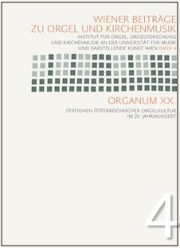Anton Heiller also worked in Switzerland
Lecturers from the University of Music and Performing Arts Vienna write about Austrian organ culture in the 20th century, in particular the Viennese organist, composer and organ teacher Anton Heiller.

At first glance, this publication appears to have more of a regional focus by focusing on the organ culture of our neighboring country to the east, which today probably occupies a marginal place in the Swiss church music and concert scene. However, it quickly becomes apparent that the four contributions by three lecturers at the University of Music and Performing Arts Vienna are indeed of great interest.
The focus is on the Viennese organist, composer and organ teacher Anton Heiller (1923-1979), who not only trained and influenced a large number of Swiss organists during his years of teaching, but was also very closely associated with our country through his concert activities and recordings. In his three-part article, Roman Summereder first gives a brief but fascinating overview of organ composition in the 20th century, which also includes lesser-known trends and composers' names and thus fortunately shifts the focus somewhat away from the often very dominant French organ works.
After sketches of Heiller's biography and aesthetics, Summereder then presents his entire organ oeuvre with brief analytical descriptions, information on the background of the works and their history through to the editions and any corrections and printing errors. The third part deals with the interpreter Heiller, and not, as one might expect, in relation to Bach, but to works by Max Reger, Franz Schmidt and Paul Hindemith. A facsimile reproduction of Reger's Choral Fantasy Awake, the voice calls us with registrations for the Rudigier organ in Linz Cathedral illustrates Heiller's approach of transferring the work to an "unfamiliar" instrument; the result can be heard on the enclosed CD, as well as another work and the well-known improvisation on Ave Maris Stella. Valuable information on Heiller's registration practice in Hindemith's organ sonatas allows conclusions to be drawn about the work between performer and composer and about Hindemith's approach to the organ.
Subsequently, two texts by Wolfgang Kreuzhuber shed light on the history and aesthetics of the Marcussen organ in Linz Cathedral and the associated change in sound in a country that for a relatively long time remained committed to a late Romantic organ sound. Using the example of the organ of St. Ursula in Vienna (1968) and its models, Peter Planyavsky expands on this theme in the final chapter.
Conclusion: an extraordinarily interesting publication that provides a wealth of information about that Departure of the sounds (this is the title of another publication by Roman Summereder, Edition Helbling 1995, which is recommended reading), who also gave decisive impulses to organ culture outside Austria, and especially in Switzerland.
Organum XX. Stations of Austrian Organ Culture in the 20th Century, Volume 4 of the series "Wiener Beiträge zu Orgel und Kirchenmusik", published by the Institute for Organ, Organ Research and Church Music at the University of Music and Performing Arts Vienna, 2018. 224 p., incl. audio CD, € 35.00








